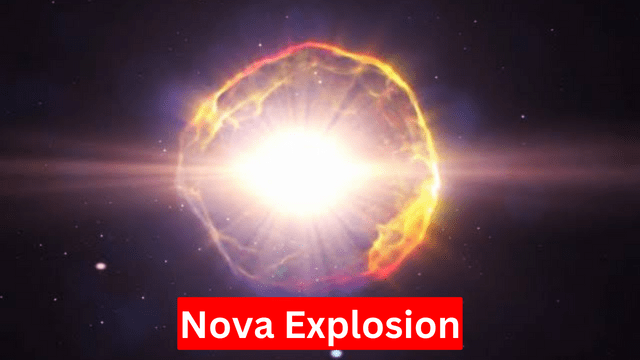NASA anticipates a nova outburst, an even more uncommon cosmic phenomenon. It is anticipated that T Coronae Borealis will nova at any time between this moment and September 2024. When the nova approaches its maximum brightness, observers should be able to see it for a few days, according to astronomers.
Nova Explosion 2024 Date
Even though the solar eclipse is over, we strongly advise you to continue watching the skies because the Milky Way is going to witness a nova, which is a gigantic star explosion. In actuality, it occurred thousands of years ago, but it is only now becoming apparent to us.
T Coronae Borealis, often known as the “Blaze Star,” is located approximately three thousand light years away and is predicted to burst at any time between now and September. According to a NASA astronomer who spoke with NPR, it only explodes once every 80 years, making it a once-in-a-lifetime experience.
Although the precise date is unknown, we are certain that the star will burst into flame before September 2024. You should be prepared for this year’s noteworthy event.
What is Nova?
The word nova means “new star” in Latin. It occurs when a normally dark region of the solar system suddenly radiates bright light, making itself visible to the unaided eye and appearing to be a rising star.
Only binary star systems, where one “dead” star (usually a large red giant) and the other a “dying” star (also called a white dwarf), can produce a nova. Because of their synchronized orbits, the white dwarf’s surface becomes coated with debris that the red giant excretes.
A nova, or explosion of energy, is the result of the substance eventually building up. The night skies become brighter, with a rapid and dramatic boost in brightness. These occurrences are typically only seen with a strong telescope. However, the impending nova eruption of T Coronae Borealis will be visible to the unassisted eye.
When will you expect to see the Nova in 2024?
It’s interesting to note that NASA is unsure of the exact timing of this. The precise timing of a nova explosion is more elusive than that of a solar eclipse. However, NASA thinks it will occur sometime in September of this year.
The beneficial aspect is that you will have several nights to witness the eruption of T Coronae Borealis, different from the solar eclipse, you will have just a few seconds to view it. According to NASA, T CrB’s light will increase from a magnitude +10 to a magnitude +2, bringing it closer to the brightness of the North Star.
Until then, the white dwarf is invisible. Humans should be able to see T CrB for a little more than a week if they use binoculars. It should become visible to the unaided eye for several days. However, shortly after that, the star’s brilliance will decrease once more, and it will take another 80 years for people to live here to see the show once more.
What is the cause of the nova explosion?
A nova explosion is a dramatic event that occurs in a binary star system, where one of the stars is a white dwarf. The process leading to a nova explosion involves several steps:
- Accretion of Hydrogen: The white dwarf, which is a dense remnant of a star that has exhausted its nuclear fuel, pulls in hydrogen-rich material from its companion star.
- Increase in Pressure and Temperature: As the hydrogen accumulates on the surface of the white dwarf, the pressure and temperature increase to a critical point.
- Thermonuclear Runaway: Once a sufficient layer of hydrogen has built up, the intense pressure and heat ignite a thermonuclear runaway reaction. This reaction rapidly burns the hydrogen, releasing a tremendous amount of energy.
- Explosion and Ejection of Material: The energy released from the runaway reaction causes a sudden and violent ejection of the outer layers of the white dwarf. This ejection produces a bright flash of light and expels material into space at high velocities.
- Shock Waves: Recent studies have shown that most of the visible light from a nova explosion arises from shock waves. These are abrupt changes in pressure and temperature that occur within the explosion debris. These shock waves can also accelerate particles to high energies, which can produce gamma rays.
Is the Nova explosion harmful to humans?
Observing a Nova explosion is a safe activity for stargazers. Humans cannot be harmed by a nova explosion like the one predicted to occur from T Coronae Borealis. Because novae occur so distant from Earth, our planet is not directly threatened by them.
Although novae are extremely strong occurrences, they cannot be nearly as strong as much larger explosions known as supernovas or kilonovae. Although supernovae and kilonovae can have an enormous effect on the space around them, they would need to pass relatively close to Earth to directly affect it.
The ability to conduct scientific research and the opportunity for stargazers to see a unique and breathtaking celestial event are the two main implications of nova explosions on Earth. Thus, if and when T CrB erupts, it will be a thrilling event for astronomy aficionados everywhere, with no threat to Earthly life.
Go to GMR Homepage.

